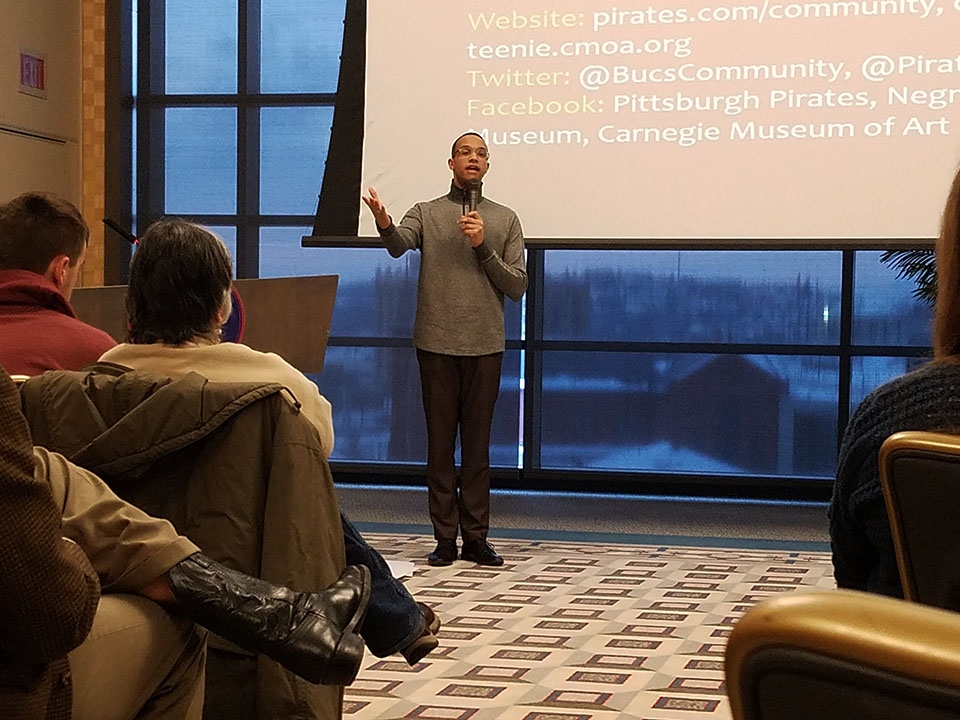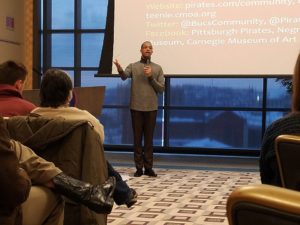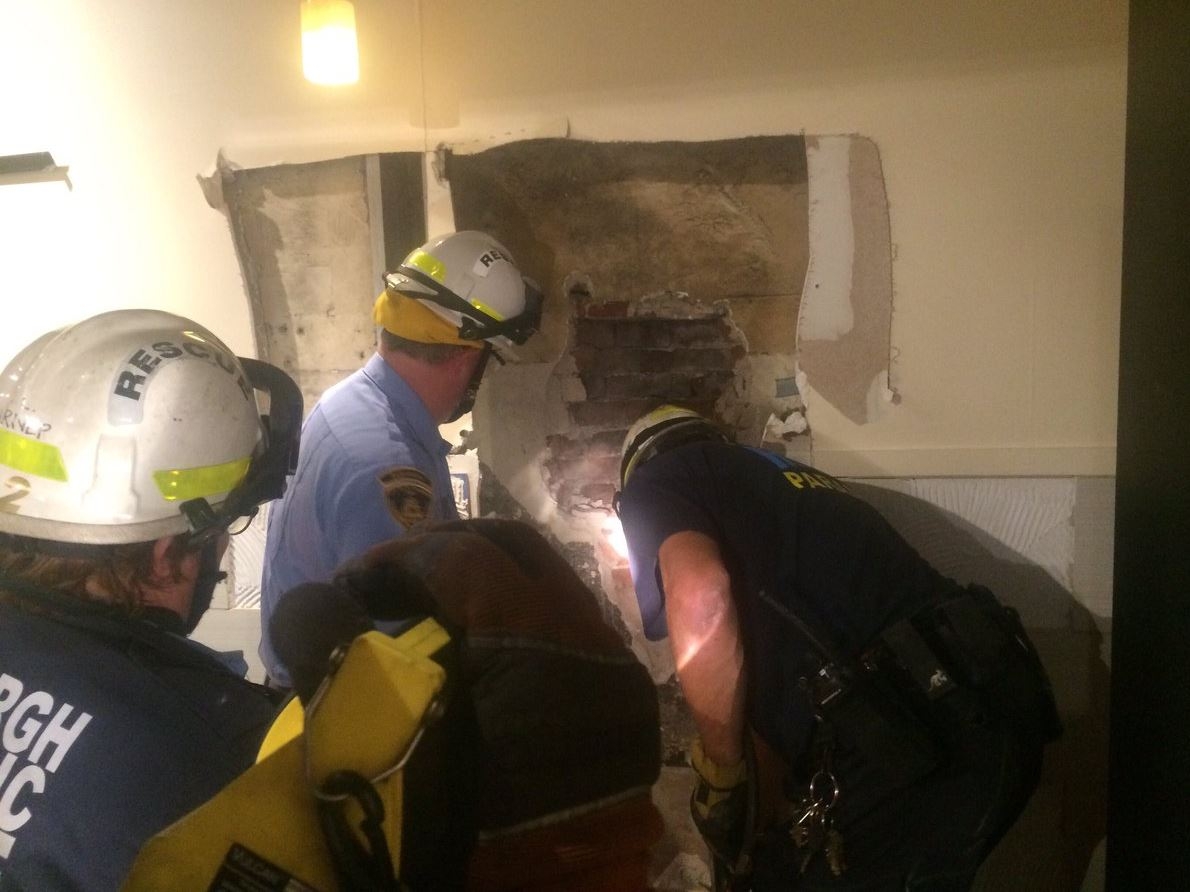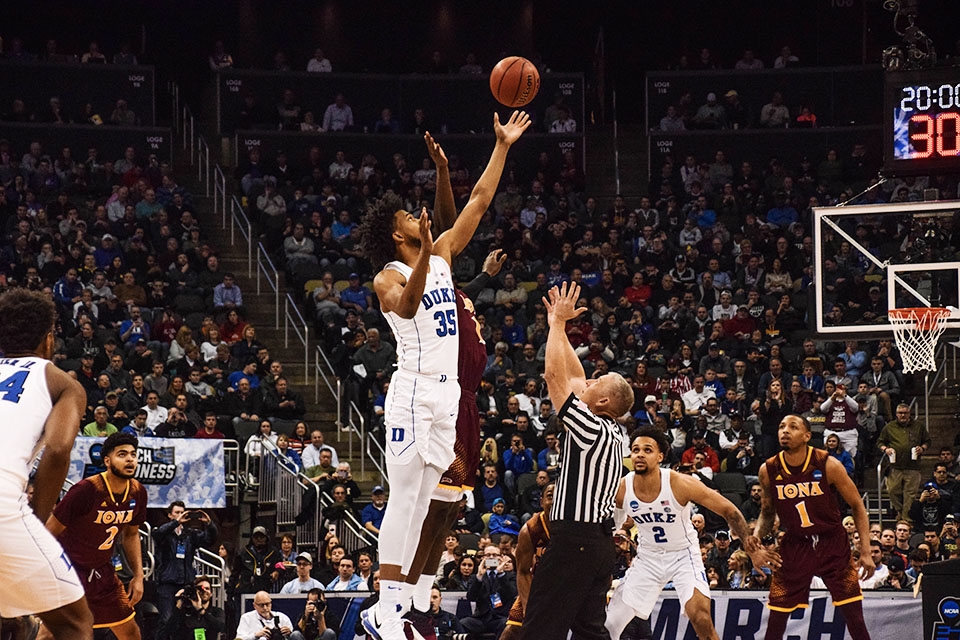
Joel Gray, community outreach coordinator for the Pittsburgh Pirates, gave a talk on the history of Pittsburgh Negro League baseball on Feb. 8 in the Power Center.

Joel Gray, community outreach coordinator for the Pittsburgh Pirates, gave a talk on the history of Pittsburgh Negro League baseball on Feb. 8 in the Power Center.
Raymond Arke | News Editor
02/15/18
Just blocks away from Duquesne was the home of some of the greatest baseball players ever. However, many of their names and contributions have fallen from memory. On Feb. 8, the Pittsburgh Pirates hoped to change that neglect by giving a presentation on Negro League baseball in Pittsburgh to a full room of Duquesne students.
Jeff Mallory, director of the Office of Diversity and Inclusion, opened the presentation Long Live Their Legacy, calling it “truly unique and special.”
Mallory also pointed out that Duquesne is connected to the Negro Leagues through Cumberland Posey. Posey played basketball at Duquesne and then later played Negro League baseball and owned the Homestead Grays. Posey’s granddaughter is also a Duquesne graduate, Mallory said.
Mallory introduced Joel Gray, community outreach coordinator for the Pittsburgh Pirates. He went on to explain that Gray is a “near and dear friend. … [We are] nothing short of thankful for his presence.”
Gray opened the talk by leading the well-attended room in a chant of “Let’s Go Bucs.” He explained that it is necessary for the Pirates to raise awareness of these past players.
“It should be our duty as a pro baseball team to tell their story,” Gray said.
He told the stories of African Americans and baseball going back to the mid-1800s. During those early years, both races played baseball together. One of these early African-American pioneers was John “Bud” Fowler. Fowler was the first black professional baseball player who also worked as a liaison between white owners and other black players.
However, the racial togetherness of the early years of baseball did not last long. Gray said that as early as 1871, an all-black team called the Philly Pythons were not allowed to compete in the first professional baseball league, the National Association of Baseball Players.
Part of the growing support of segregation in baseball was that the all-black teams were showing up the all-white teams. It was like having “a team of Lebron [James] versus a team of Big Bens,” Gray said. More white players began to refuse to play. Once Major League Baseball was formed, a “gentleman’s agreement” was reached among the owners to not to sign African Americans.
As such, Gray explained, an entire race was left out of the sport. To remedy this problem, a Southern-born African American, Andrew “Rube” Foster, had an idea.
“He had a vision. He knew what it took to get black players back to baseball,” Gray said.
On Feb. 20, 1920, Foster brought eight all-black teams together and formed the Negro National League. Several other all-black leagues developed to rival it. The League would run until 1931 when the struggles of the Great Depression brought it to its end. In 1933, the ideas were revived and two leagues, a National and an American, would run until 1960.
Gray discussed Pittsburgh’s two incredibly successful Negro League franchises, the Homestead Grays and the Pittsburgh Crawfords. The Grays had existed since 1910, before the Negro Leagues even existed. They shared a home with the Pirates in Forbes Field.
The Pittsburgh Crawfords were based in the Hill District, Gray said.
“They played right up the street” in one of the first stadiums built for just a Negro League team, he said.
The Grays and the Crawfords had some of the best talent in baseball history and put on an entertaining product, Gray explained.
“These guys filled stadiums,” Gray said. “[They had] some of the best baseball players ever.”
The African-American teams played with a fast and flashy style that had a long-lasting effect on baseball as a sport.
“[They] were innovators of the game. These gentlemen made Pittsburgh the Mecca of baseball,” Gray explained.
Two of the greatest of these black players, Josh Gibson and Satchel Paige, played for both the Grays or Crawfords at various points in the 1930s and 40s.
“Josh Gibson was the best batter ever,” Gray said, highlighting his over 800 career home runs and Gibson’s 587-foot home run he launched out of Yankee Stadium. Comprehensive statistics are hard to come by because record-keeping was spotty at best for Negro League players.
Gray described Satchel Paige, a pitcher, as “a legend.” Paige eventually made it to the MLB as a 42-year-old in 1948 and played until he was 58, making the All-Star team twice.
After discussing other notable Negro League stars like Cool Papa Bell and Smokey Joe Williams, Gray discussed the first African American to play on the Pirates, Curt Roberts. Roberts was signed by then-Pirates general manager Branch Rickey, who had desegregated the MLB by signing Jackie Robinson to the Brooklyn Dodgers several years earlier, Gray said.
The Pirates also have another unique first. On Sept. 1, 1971, they fielded the first ever all-minority lineup in baseball history.
Gray said that the contributions African Americans and other minorities had to baseball are immeasurable.
“These guys made baseball. They really rocked the game,” he said.
Gray was happy to see so many Duquesne students at the presentation.
“Shout out to the Dukes for showing up tonight. It was a great turnout,” he said.
With Opening Day just around the corner, Gray said he hopes the students keep in mind what they learned for the upcoming season.
“I hope they walk away with a new perspective on baseball,” he said.
Also in attendance was Jona Dechellis, the community relations coordinator for the Pirates and a Duquesne graduate. She came along with Gray to visit her alma mater. Dechellis’ job with the Pirates is to oversee their donations to nonprofits, and she works with the players to sign autographs.



